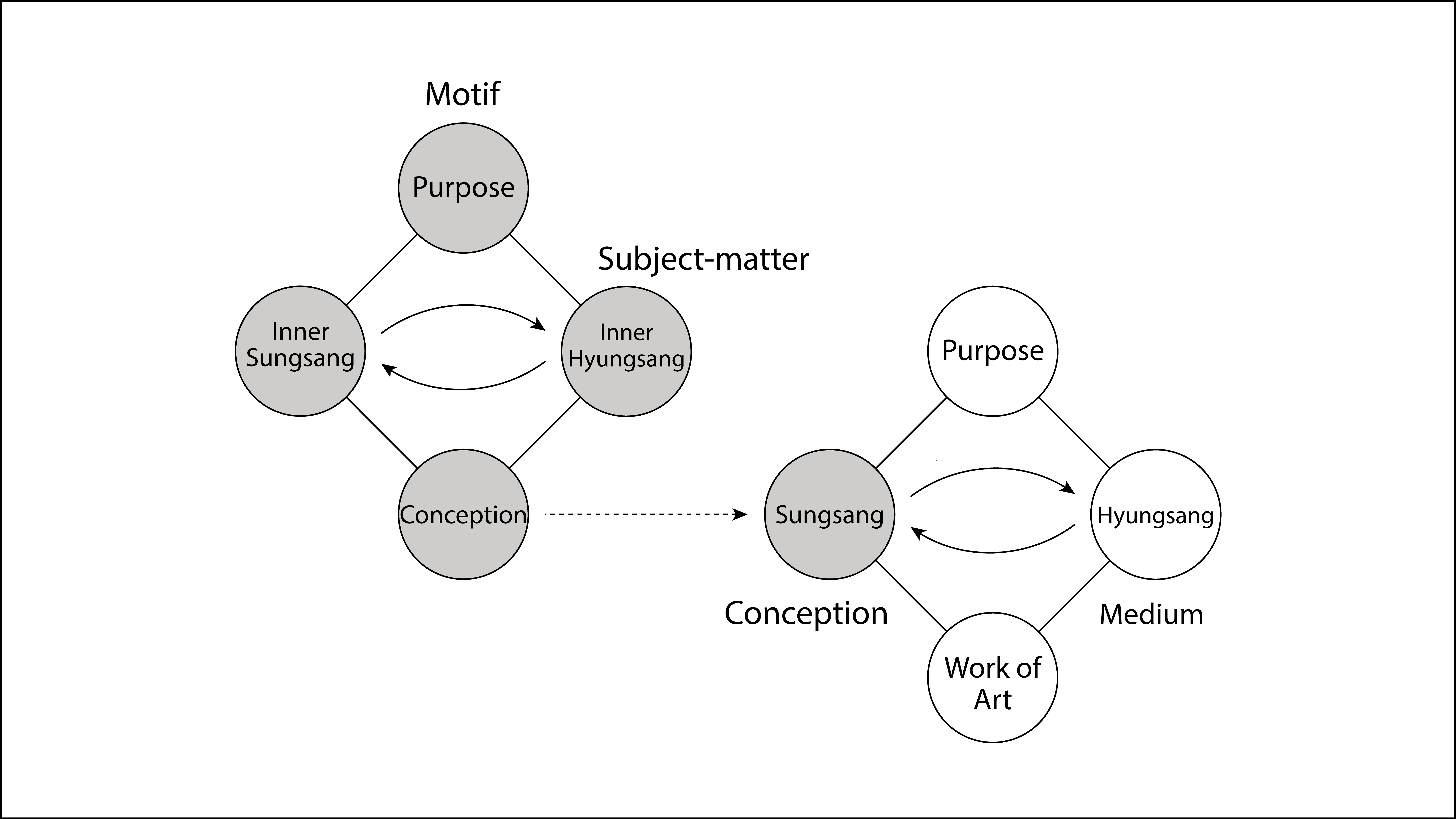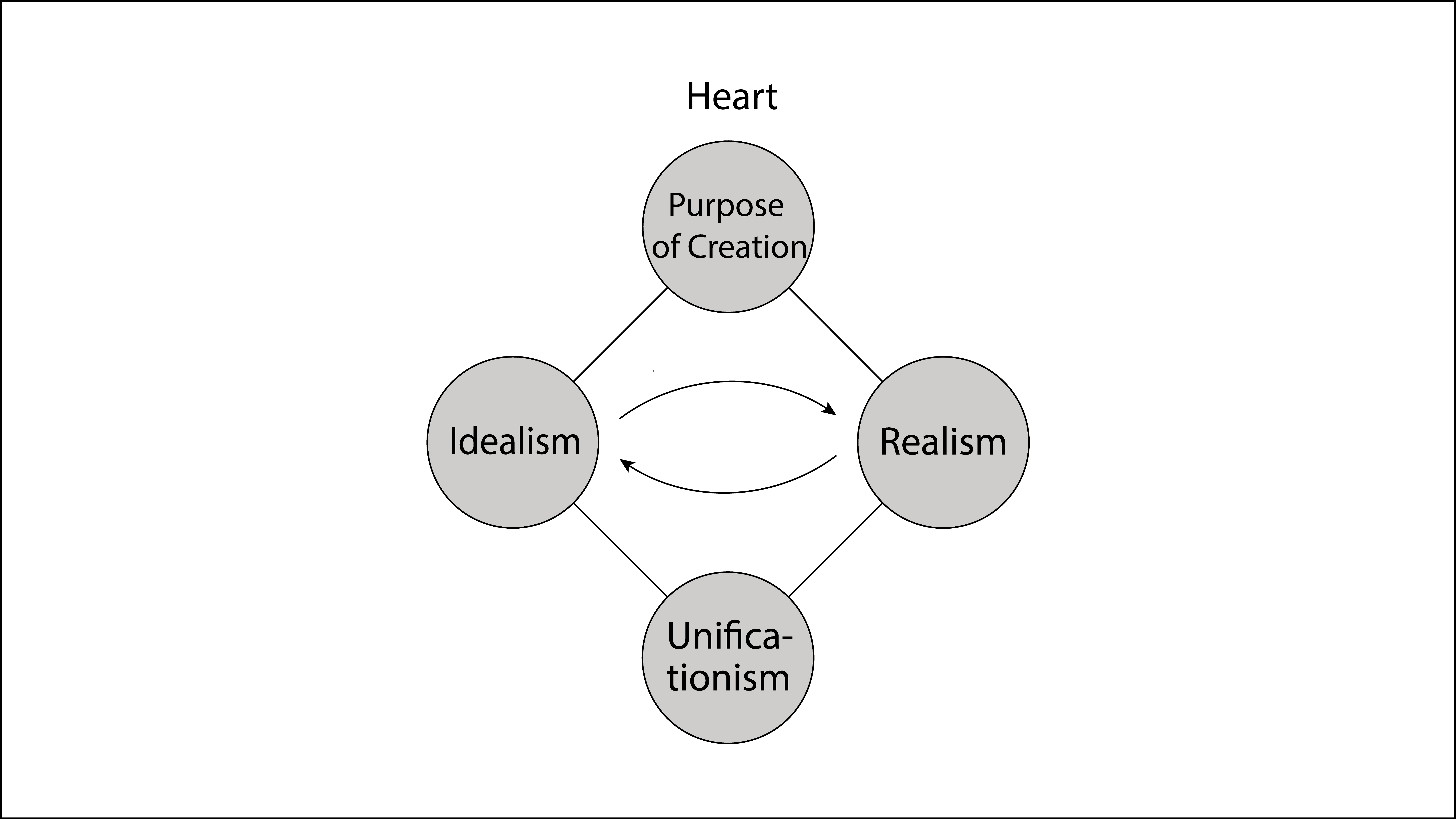Technique and Materials
The two-stage structure in the Original Image refers to the two-stage structure in which, first, the Inner Sungsang and Inner Hyungsang engage in give and receive action, centering on purpose, to form Logos, and next, the Logos and Hyungsang engage in give and receive action, centering on purpose, to form a created being. All human creative activities are performed through this same process. For example, activities such as manufacturing, farming, scholarly research, and industrial research, are carried out according to this two-stage structure of creation.
This holds true also in the creation of artistic works. I have already explained the formation of the inner four position foundation in terms of the requisites for the subject. To repeat, centering on the motif (purpose), the inner Sungsang (intellect, emotion, and will) and inner Hyungsang (theme) engage in give and receive action and produce a conception (plan). This is the formation of the inner four position foundation. Next, based on this conception (plan) which has been formed through the inner four position foundation, the artist brings into being a work of art, using materials. In other words, the outer four position foundation is formed through give and receive action, centering on the motif (purpose), between the Sungsang (conception) and the Hyungsang (materials). In the formation of the outer four position foundation, the actual creation of a work of art, special techniques or abilities are usually required.
Next, I will explain about the materials necessary in creating a work of art. The materials required consist of the Sungsang materials (i.e., the object of expression) and the Hyungsang materials (i.e., the means of expression). The Sungsang materials are called the “subject-matter.” In writing, actions and events, whether they are real or fictitious, are the subject-matter. In painting, the people, landscape, and other images are the subject-matter. Thus, the subject-matter means the content of the theme.
The Hyungsang materials (i.e., physical materials) are called the “medium.” In a sculpture, such materials as chisels, marble, wood, and bronze are necessary. In painting, paints, canvasses, and so on are necessary. In producing a work of art, the artist determines the required quality and quantity of these physical materials and then utilizes them in concrete creative actions.
In this way, the artist first produces a conception (plan), and then completes the work by using specific materials. This process is called the two-stage structure of artistic creation, 11 which is illustrated in fig. 7.2.

Fig.7.2.Two-Stage Structure of Artistic Creation
Various Styles, and the Schools of Artistic Creation
The style of artistic creation refers to the method through which one manifests one’s artistic expression, which is the particular way in which the two-stage structure of artistic creation is actually formed. Of particular importance here is the manner in which the inner four position foundation is formed, that is, the style of conception. The inner four position foundation is formed through the give and receive action between the inner Sungsang (intellect, emotion, and will) and inner Hyungsang (theme), centering on the motif (purpose).
Therefore, when there are differences in the motif, these will be reflected as differences in the finished works as well. Even with the same motif, with differences in the inner Sungsang, works will differ. Also, with differences in the inner Hyungsang, works will likewise differ. In the instance of variations or differences in any of the elements in any of the three positions in the inner four position foundation, the results (conceptions) will differ, and the works, also, will differ. This is the origin of the various styles of artistic creation. Based on these various styles, different schools of art have appeared historically. A few of the schools of art in history are described as follows:
- Idealism: Idealism is a style that seeks to express ideal beauty by idealizing human beings and the world. Many of the sixteenth-century Renaissance artists were idealists. Raphael is a representative painter of this school.
- Classicism: Classicism refers to the artistic tendency in the seventeenth and eighteenth centuries to follow the examples of the forms of expression of Greco-Roman art. It attached importance primarily to form, seeking to achieve unity and balance. A representative literary work is Faust by Johann W. von Goethe (1749-1832). Among the painters, we can mention Jacques L. David (1748-1825) and Jean A. D. Ingres (1780-1867).
- Romanticism: As a reaction to classicism’s focus on form, romanticism (eighteenth and nineteenth centuries) sought to give expression to the passions. Among romanticists, we can mention the writer Victor Hugo (1802-85), the poet Lord Byron (1788-1824), and the painter Eugene Delacroix (1798-1863).
- Realism/Naturalism: Realism is a tendency to depict reality as it is. This style emerged as a reaction against romanticism, during the period from the mid to the late nineteenth century. Representatives of this school are such painters as Jean B. C. Corot (1796-1875), Jean F. Millet (1814-75), and Gustave Courbet (1819-77), and the writer Gustave Flaubert (1821-80). The style of realism developed a tendency toward positivism and scientism which led it to naturalism. A representative writer of the school of naturalism is Emile Zola (1841-1920). In the area of the fine arts, there was no distinction between realism and naturalism.
- Symbolism: Symbolism arose from the late nineteenth century to the early twentieth century as a reaction against realism/naturalism. As a school of literature, it sought to express feelings with symbols, abandoning the traditions and forms of the past. A representative of this school is the poet Arthur Rimbaud (1854-91).
- Impressionism: The school of impressionism considered the image caught in a single instant to be the true image of things, and sought to express individual and momentary impressions of shapes and colors. This movement was born and developed in France in the late nineteenth century. Edouard Manet (1832-83), Claude Monet (1834-1917), Pierre A. Renoir (1841-1919) and Edgar Degas (1834-1917) are representative painters of this school.
- Expressionism: Contrary to impressionism, which depicted impressions coming from the outside, expressionism sought to express internal human feelings. It arose as a reaction against impressionism in the early twentieth century. The painters Vasily Kandinsky (1866-1944) and Franz Marc (1880-1916) and the writer Franz Werfel (1890-1945) are representative artists of this school.
- Cubism: Cubism, a fine-arts movement of the early twentieth century, sought to disassemble objects into simple shapes and then reassemble them according to the artist’s subjectivity. A representative painter of this school is Pablo Picasso (1881-1973).
- Unificationism: Finally, how could we characterize the artistic style of the Unification Theory of Art? It is a style in which idealism and realism are united, centering on the purpose of creation. As such, it is called Unificationism (see fig. 7.3).

Fig.7.3. Artistic Style of Unificationism
Since Unificationism seeks to realize the Kingdom of Heaven on earth, it regards reality as important. Accordingly, Unificationism has a pronounced sense of realism. At the same time, however, it strives, even while living in the real world to return to the original ideal world. So, the unification style includes idealism as well. Therefore, the unity of reality and the ideal becomes the Unificationist attitude of creation. For example, Unificationism would depict the image of a human being motivated by hope, seeking to overcome all hardships in the actual sinful world, all the while longing for the original ideal world. Unificationism is “Heartism,” that is, a theory centered on God’s Heart. Thus, Unificationism seeks to express ideal love centered on God, which naturally contains romantic elements as well. However, this is not like the romanticism of the past. When dealing with the love between a man and a woman, it will depict the ideal and realistic love between a man and a woman centered on God’s love and on the love of the True Parents of humankind.
The various styles and schools of art mentioned above can be divided, in a broad sense, into realism and idealism, whereby realism is understood not in the sense of “a style that depicts reality as it is,” but in the sense of “a style that is considered currently fashionable in a specific period,” and whereby idealism is understood not in the sense of “a style that depicts ideal human beings and ideal reality,” but in the sense of “a style that attempts to give rise to something new, and is oriented toward the future, in contradistinction to what might be currently fashionable in a specific period.” In this broad sense, each of the past styles started out as an “idealism,” but later became a “realism.” It can be said that Unificationism as a style of art is the “unity of realism and idealism” in this sense as well.
This style of Unificationism, which is a style patterned after God’s creative act centered on Heart and on the purpose of creation, is basically unchangeable and eternal, even though there may be some differences based on the individualities of different artists.